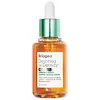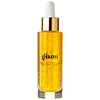What's inside
What's inside
 Key Ingredients
Key Ingredients

 Benefits
Benefits

 Concerns
Concerns

 Ingredients Side-by-side
Ingredients Side-by-side

Water
Skin ConditioningPropanediol
SolventGlycerin
HumectantPentylene Glycol
Skin ConditioningBetaine
HumectantCoco-Caprylate/Caprate
EmollientCaffeine
Skin ConditioningCopper Tripeptide-34
Skin ConditioningNiacinamide
SmoothingCastor Oil/Ipdi Copolymer
Aloe Barbadensis Leaf Juice
Skin ConditioningCoffea Arabica Seed Oil
MaskingPanax Ginseng Root Extract
EmollientBiotin
AntiseborrhoeicCaprylic/Capric Triglyceride
MaskingLimnanthes Alba Seed Oil
Skin ConditioningCarbomer
Emulsion StabilisingLindera Strychnifolia Root Extract
Skin ConditioningHippophae Rhamnoides Oil
EmollientTrisodium Ethylenediamine Disuccinate
Acacia Senegal Gum
MaskingXanthan Gum
EmulsifyingPhyllanthus Emblica Fruit Extract
HumectantTocopheryl Acetate
AntioxidantHelianthus Annuus Hybrid Oil
EmollientLamium Album Extract
AstringentPlantago Psyllium Seed Extract
Skin ConditioningPanthenol
Skin ConditioningC12-15 Alkyl Benzoate
AntimicrobialSodium Metabisulfite
AntioxidantLarix Europaea Wood Extract
HumectantGlycine
BufferingTocopherol
AntioxidantUbiquinone
AntioxidantZinc Chloride
AntimicrobialSimmondsia Chinensis Seed Oil
EmollientLithospermum Erythrorhizon Root Extract
Skin ConditioningCamellia Sinensis Leaf Extract
AntimicrobialCitric Acid
BufferingPotassium Sorbate
PreservativeSodium Benzoate
MaskingSodium Hydroxide
BufferingBenzyl Alcohol
PerfumingCaramel
Cosmetic ColorantWater, Propanediol, Glycerin, Pentylene Glycol, Betaine, Coco-Caprylate/Caprate, Caffeine, Copper Tripeptide-34, Niacinamide, Castor Oil/Ipdi Copolymer, Aloe Barbadensis Leaf Juice, Coffea Arabica Seed Oil, Panax Ginseng Root Extract, Biotin, Caprylic/Capric Triglyceride, Limnanthes Alba Seed Oil, Carbomer, Lindera Strychnifolia Root Extract, Hippophae Rhamnoides Oil, Trisodium Ethylenediamine Disuccinate, Acacia Senegal Gum, Xanthan Gum, Phyllanthus Emblica Fruit Extract, Tocopheryl Acetate, Helianthus Annuus Hybrid Oil, Lamium Album Extract, Plantago Psyllium Seed Extract, Panthenol, C12-15 Alkyl Benzoate, Sodium Metabisulfite, Larix Europaea Wood Extract, Glycine, Tocopherol, Ubiquinone, Zinc Chloride, Simmondsia Chinensis Seed Oil, Lithospermum Erythrorhizon Root Extract, Camellia Sinensis Leaf Extract, Citric Acid, Potassium Sorbate, Sodium Benzoate, Sodium Hydroxide, Benzyl Alcohol, Caramel
Water
Skin ConditioningPropanediol
SolventCoco-Caprylate/Caprate
EmollientBetaine
HumectantCaprylic/Capric Triglyceride
MaskingPentylene Glycol
Skin ConditioningMel
EmollientPropolis Cera
AntiseborrhoeicLimnanthes Alba Seed Oil
Skin ConditioningVitis Vinifera Seed Oil
EmollientCarthamus Tinctorius Seed Oil
MaskingHelianthus Annuus Seed Oil
EmollientHydrolyzed Pea Protein
EmollientHydrolyzed Vegetable Protein
Skin ConditioningHippophae Rhamnoides Oil
EmollientOenothera Biennis Oil
EmollientRosa Canina Fruit Oil
EmollientTocopherol
AntioxidantCalendula Officinalis Flower Extract
MaskingHelianthus Annuus Sprout Extract
Skin ConditioningCaesalpinia Spinosa Fruit Pod Extract
Daucus Carota Sativa Root Extract
Skin ConditioningCitrus Aurantium Bergamia Fruit Extract
Skin ConditioningParfum
MaskingCastor Oil/Ipdi Copolymer
Maltodextrin
AbsorbentAcrylates/C10-30 Alkyl Acrylate Crosspolymer
Emulsion StabilisingChlorphenesin
AntimicrobialCarbomer
Emulsion StabilisingSodium Hydroxide
BufferingTrisodium Ethylenediamine Disuccinate
Acacia Senegal Gum
MaskingXanthan Gum
EmulsifyingTamarindus Indica Seed Gum
Emulsion StabilisingPotassium Sorbate
PreservativeSodium Benzoate
MaskingGlucose
HumectantCI 40800
Cosmetic ColorantLimonene
PerfumingLinalool
PerfumingHexyl Cinnamal
PerfumingCoumarin
PerfumingWater, Propanediol, Coco-Caprylate/Caprate, Betaine, Caprylic/Capric Triglyceride, Pentylene Glycol, Mel, Propolis Cera, Limnanthes Alba Seed Oil, Vitis Vinifera Seed Oil, Carthamus Tinctorius Seed Oil, Helianthus Annuus Seed Oil, Hydrolyzed Pea Protein, Hydrolyzed Vegetable Protein, Hippophae Rhamnoides Oil, Oenothera Biennis Oil, Rosa Canina Fruit Oil, Tocopherol, Calendula Officinalis Flower Extract, Helianthus Annuus Sprout Extract, Caesalpinia Spinosa Fruit Pod Extract, Daucus Carota Sativa Root Extract, Citrus Aurantium Bergamia Fruit Extract, Parfum, Castor Oil/Ipdi Copolymer, Maltodextrin, Acrylates/C10-30 Alkyl Acrylate Crosspolymer, Chlorphenesin, Carbomer, Sodium Hydroxide, Trisodium Ethylenediamine Disuccinate, Acacia Senegal Gum, Xanthan Gum, Tamarindus Indica Seed Gum, Potassium Sorbate, Sodium Benzoate, Glucose, CI 40800, Limonene, Linalool, Hexyl Cinnamal, Coumarin
Ingredients Explained
These ingredients are found in both products.
Ingredients higher up in an ingredient list are typically present in a larger amount.
Acacia Senegal Gum has skin soothing, thickening, and formulation stabilizing properties. It comes from the Acacia tree that is native to sub-Saharan Africa.
Betaine is a common humectant (a substance that promotes retention of moisture). It's known to be gentle on the skin and can help balance hydration.
This ingredient is best for improving hydration and soothing irritated skin. Studies also show it helps even out skin tone.
Fun fact: Betaine is naturally created in the skin and body. The kind found within cosmetic products can be either plant-derived or synthetic.
Another name for betaine is trimethylglycine.
Learn more about BetaineThis ingredient is an emollient, solvent, and texture enhancer. It is considered a skin-softener by helping the skin prevent moisture loss.
It helps thicken a product's formula and makes it easier to spread by dissolving clumping compounds.
Caprylic Triglyceride is made by combining glycerin with coconut oil, forming a clear liquid.
While there is an assumption Caprylic Triglyceride can clog pores due to it being derived from coconut oil, there is no research supporting this.
Learn more about Caprylic/Capric TriglycerideCarbomer is a polymer of acrylic acid. Its main role is to create a gel consistency.
A high amount of carbomer can cause pilling or balling up of products. Don't worry, most products contain 1% or less of carbomer.
Castor Oil/Ipdi Copolymer is an oil and isn't fungal acne safe.
Coco-Caprylate/Caprate is created from fatty coconut alcohol, caprylic acid, and capric acid.
It is a lightweight emollient. Emollients create a thin barrier on the skin to trap moisture in. This helps keep your skin hydrated and soft.
Once applied, Coco-Caprylate/Caprate is absorbed quickly and leaves a silky feel.
Coco-Caprylate/Caprate may not be fungal acne safe.
Learn more about Coco-Caprylate/CaprateHippophae Rhamnoides Oil also known as seabuckthorn oil. This oil is usually extracted from the fruit pulp or seeds.
Seabuckthorn is rich in phytosterols, carotenoids, Vitamins A, C, and E. This gives it strong antioxidant properties that can help soothe and protect your skin from oxidative damage.
This oil is rich in fatty acids, including: two types of linoleic acid (~30-34%), oleic acid (17%), and palmiteic acid (35%). Note these numbers are averages, and different parts of the plant will vary.
Palmitoleic acid has been shown to help soothe inflammation and promote wound healing. It is also naturally found in the fat of our skin.
Overall, seabuckthorn oil is great for nourishing, hydrating, and soothing skin. While it shows UV protecting properties, it should not replace sunscreen.
Due to the rich fatty acid content, this ingredient may not be Malassezia folliculitis, or fungal acne, safe.
Seabuckthorn berries are little orange fruits. This plant is native to Asia.
Learn more about Hippophae Rhamnoides OilLimnanthes Alba Seed Oil is the oil extracted from the seeds of the meadowfoam plant. This oil is non-fragrant and is an emollient. As an emollient, meadowfoam seed oil helps soften and hydrate the skin.
Meadowfoam seed oil is stable and has a long shelf life due to its chemical structure. It has the highest concentration of stable fatty-acids among plant oils, preventing it from degrading once exposed to oxygen.
Due to the fatty acid content, this ingredient may not be fungal-acne safe.
Meadowfoam is native to California and Oregon.
Learn more about Limnanthes Alba Seed OilPentylene glycol is typically used within a product to thicken it. It also adds a smooth, soft, and moisturizing feel to the product. It is naturally found in plants such as sugar beets.
The hydrophilic trait of Pentylene Glycol makes it a humectant. As a humectant, Pentylene Glycol helps draw moisture from the air to your skin. This can help keep your skin hydrated.
This property also makes Pentylene Glycol a great texture enhancer. It can also help thicken or stabilize a product.
Pentylene Glycol also acts as a mild preservative and helps to keep a product microbe-free.
Some people may experience mild eye and skin irritation from Pentylene Glycol. We always recommend speaking with a professional about using this ingredient in your routine.
Pentylene Glycol has a low molecular weight and is part of the 1,2-glycol family.
Learn more about Pentylene GlycolPotassium Sorbate is a preservative used to prevent yeast and mold in products. It is commonly found in both cosmetic and food products.
This ingredient comes from potassium salt derived from sorbic acid. Sorbic acid is a natural antibiotic and effective against fungus.
Both potassium sorbate and sorbic acid can be found in baked goods, cheeses, dried meats, dried fruit, ice cream, pickles, wine, yogurt, and more.
You'll often find this ingredient used with other preservatives.
Learn more about Potassium SorbatePropanediol is an all-star ingredient. It softens, hydrates, and smooths the skin.
It’s often used to:
Propanediol is not likely to cause sensitivity and considered safe to use. It is derived from corn or petroleum with a clear color and no scent.
Learn more about PropanediolSodium Benzoate is a preservative. It's used in both cosmetic and food products to inhibit the growth of mold and bacteria. It is typically produced synthetically.
Both the US FDA and EU Health Committee have approved the use of sodium benzoate. In the US, levels of 0.1% (of the total product) are allowed.
Sodium benzoate works as a preservative by inhibiting the growth of bacteria inside of cells. It prevents the cell from fermenting a type of sugar using an enzyme called phosphofructokinase.
It is the salt of benzoic acid. Foods containing sodium benzoate include soda, salad dressings, condiments, fruit juices, wines, and snack foods.
Studies for using ascorbic acid and sodium benzoate in cosmetics are lacking, especially in skincare routines with multiple steps.
We always recommend speaking with a professional, such as a dermatologist, if you have any concerns.
Learn more about Sodium BenzoateSodium Hydroxide is also known as lye or caustic soda. It is used to adjust the pH of products; many ingredients require a specific pH to be effective.
In small amounts, sodium hydroxide is considered safe to use. However, large amounts may cause chemical burns due to its high alkaline.
Your skin has a natural pH and acid mantle. This acid mantle helps prevent harmful bacteria from breaking through. The acid mantle also helps keep your skin hydrated.
"Alkaline" refers to a high pH level. A low pH level would be considered acidic.
Learn more about Sodium HydroxideTocopherol (also known as Vitamin E) is a common antioxidant used to help protect the skin from free-radicals and strengthen the skin barrier. It's also fat soluble - this means our skin is great at absorbing it.
Vitamin E also helps keep your natural skin lipids healthy. Your lipid skin barrier naturally consists of lipids, ceramides, and fatty acids. Vitamin E offers extra protection for your skin’s lipid barrier, keeping your skin healthy and nourished.
Another benefit is a bit of UV protection. Vitamin E helps reduce the damage caused by UVB rays. (It should not replace your sunscreen). Combining it with Vitamin C can decrease sunburned cells and hyperpigmentation after UV exposure.
You might have noticed Vitamin E + C often paired together. This is because it is great at stabilizing Vitamin C. Using the two together helps increase the effectiveness of both ingredients.
There are often claims that Vitamin E can reduce/prevent scarring, but these claims haven't been confirmed by scientific research.
Learn more about TocopherolTrisodium Ethylenediamine Disuccinate is used to help stabilize a product.
It is a chelating agent, meaning it helps prevent metal ions from binding to other ingredients. This prevents unwanted reactions in products. Metal ions can come into a product via the water ingredient. They are found in trace amounts and are not known to be harmful.
Water. It's the most common cosmetic ingredient of all. You'll usually see it at the top of ingredient lists, meaning that it makes up the largest part of the product.
So why is it so popular? Water most often acts as a solvent - this means that it helps dissolve other ingredients into the formulation.
You'll also recognize water as that liquid we all need to stay alive. If you see this, drink a glass of water. Stay hydrated!
Learn more about WaterXanthan gum is used as a stabilizer and thickener within cosmetic products. It helps give products a sticky, thick feeling - preventing them from being too runny.
On the technical side of things, xanthan gum is a polysaccharide - a combination consisting of multiple sugar molecules bonded together.
Xanthan gum is a pretty common and great ingredient. It is a natural, non-toxic, non-irritating ingredient that is also commonly used in food products.
Learn more about Xanthan Gum